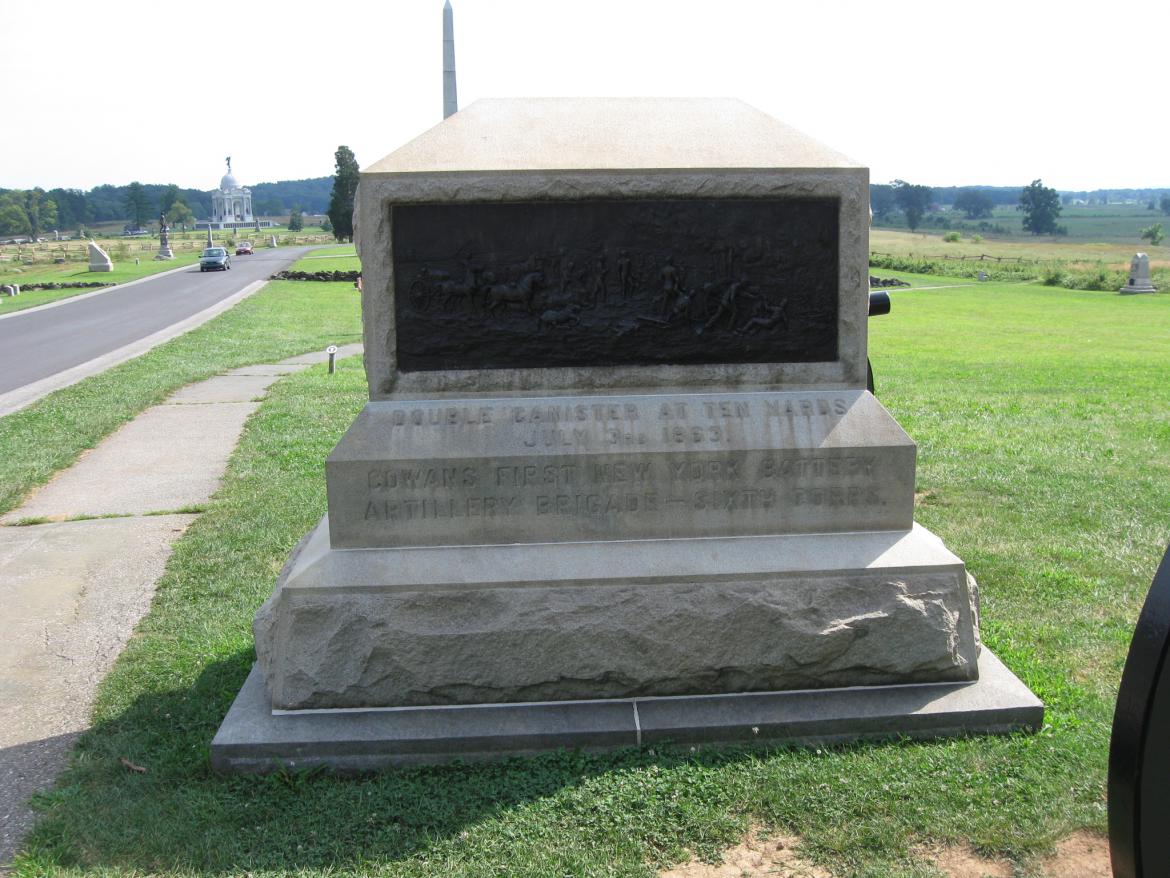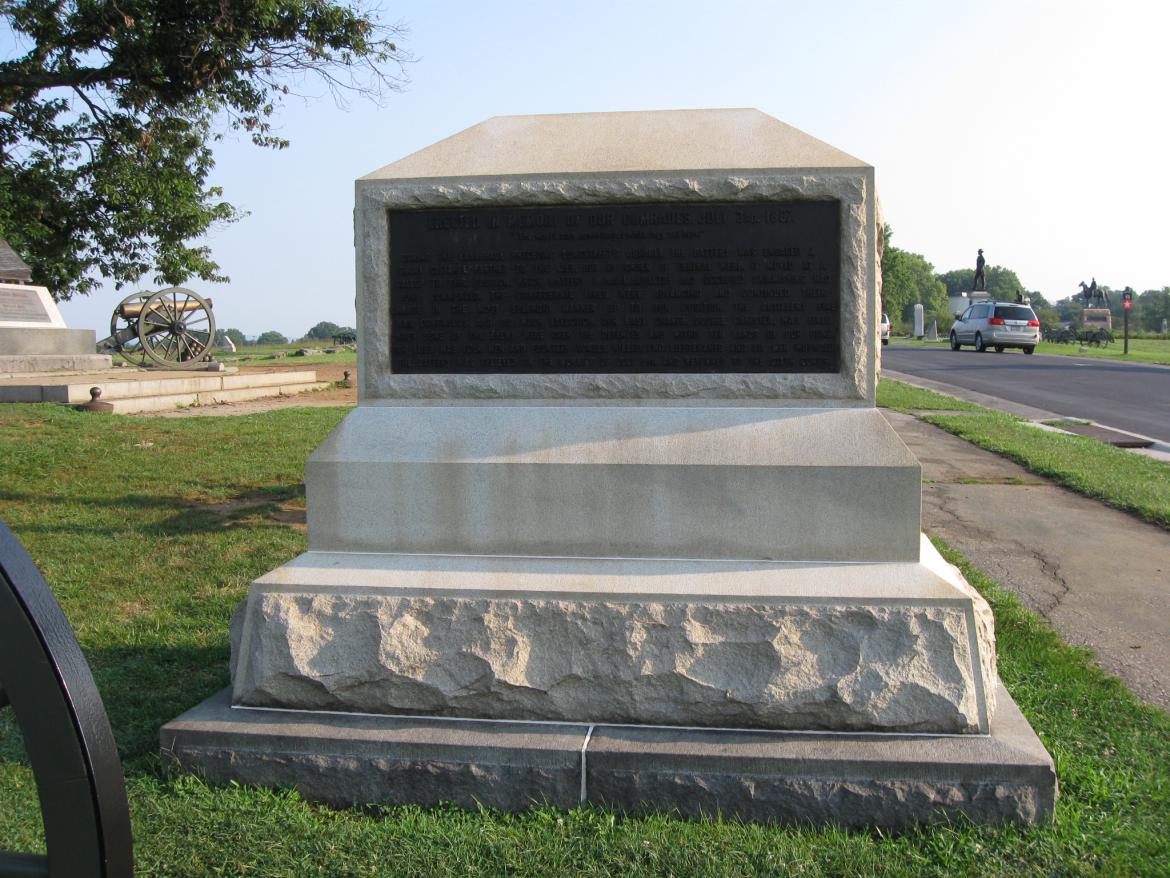The four officers of the First New York Independent Battery seated in front of their tent, are in camp on the Chickahominy River following their first battle at Lee’s Mills, Virginia (April 5-6, 1862). From left to right is Andrew Cowan (later brevet-lieutenant-colonel), then lieutenant commanding the battery (he had been promoted to captain at Lee’s Mills, but had not yet received his captain’s commission). Next is First-Lieutenant William P. Wright (who was disabled for life by wounds received in the battle of Gettysburg), Lieutenant William H. Johnson (wounded at Gettysburg and mortally wounded at Winchester), and Lieutenant Theodore Atkins, who suffered a sunstroke during the fierce cannonade at Gettysburg, July 3, 1863, and was incapacitated for further service in the army. Private Henry Hiser, in charge of the officers’ mess at the time, is leaning against the tent pole. This view from Francis Miller’s Photographic History of the Civil War was taken circa April, 1862.
In today’s post, George Newton described the actions of Andrew Cowan’s First New York Independent Light Artillery on July 3, 1863.
This map shows the locations of the videos that we shot on Oak Hill. Videos #1-#27 were presented in our previous artillery posts. Video #28 was taken by a limber of Cushing’s Battery. Video #29 was taken by the limber to Cushing’s Battery and by the stone wall that connected the inner and outer angles in the “High Water Mark” area. Video #30 was taken by a limber of Cushing’s Battery and by a caisson on the other (east) side of Hancock Avenue. Videos #31 and #32 were taken by the position of Brown’s Battery on July 3, 1863. Video #33 was taken by the monument to Brown’s Battery. Videos #34- #36 were filmed north of the Copse of Trees. Videos #37- #39 were filmed south of the Copse of Trees. This map was created facing north at approximately 8:00 PM on Sunday, August 30, 2009.
The monument and artillery pieces for Cowan’s First New York Independent Light Artillery are positioned southeast of the Copse of Trees. This view was taken facing northwest at approximately 11:00 AM on Sunday, August 23, 2009.
Gettysburg Licensed Battlefield Guide George Newton points out that before Cowan’s Battery reached this position, they were located near the large cedar tree which is to the left of the large obelisk (U.S. Regulars) monument. This view was taken facing south at approximately 4:00 PM on Sunday, August 23, 2009.
In Video #37 (Videos #1-#36 were shown in our previous Artillery posts) Gettysburg Licensed Battlefield Guide George Newton is on Cemetery Ridge at the position of First Battery, New York Light Artillery (Cowan’s Battery). He shows us that Cowan takes the position of Brown’s Battery B, First Rhode Island. This view was taken facing southeast to south to northwest to southwest at approximately 4:00 PM on Sunday, August 23, 2009.
When Cowan’s guns fired canister, they endangered the men of the 59th New York Infantry Regiment, whose monument is in the left background. This view was taken facing southwest at approximately 11:00 AM on Sunday, August 23, 2009.
Licensed Battlefield Guide George Newton is standing by the monument to Cowan’s Battery. Notice how someone has stuck a reproduction artillery shell in the muzzle of the cannon on the left. This view was taken facing southeast at approximately 11:00 AM on Tuesday, August 25, 2009.
In Video #38 Licensed Battlefield Guide George Newton is still on Cemetery Ridge at the position of the First Independent Battery, New York Light Artillery (Cowan’s Battery). He describes interaction of artillerist Henry Hunt with Cowan’s Battery and describes an incident with an infantryman from the 69th Pennsylvania. This view was taken facing southwest at approximately 4:00 PM on Sunday, August 23, 2009.
The First New York Independent Battery of Light Artillery was organized at Auburn, New York and mustered in on November 23, 1861. It was on duty in the defenses of Washington until March 1862, when it moved to the Peninsula by way of Fortress Monroe. The battery’s first action was at Lee’s Mills on April 5, 1862; it took part in the siege of Yorktown, and fought at Lee’s Mills again on April 16, 1862. This view was taken facing southwest at approximately 11:00 AM on Tuesday, August 25, 2009.
Cowan’s Battery served throughout the Peninsula campaign, and in all the major battles of the Army of the Potomac. It helped to repulse Early’s attack on Washington in 1864, and fought with Sheridan in the Shenandoah. The battery lost during its service two officers and sixteen enlisted men killed and mortally wounded and thirty-eight enlisted men by disease. This view was taken facing southwest at approximately 11:00 AM on Sunday, August 23, 2009.
Licensed Battlefield Guide George Newton is pointing out the approach of men in the 14th Virginia Infantry Regiment, who were a threat to capturing Cowan’s guns. This view was taken facing southwest at approximately 4:00 PM on Tuesday, August 25, 2009.
George Newton is standing by the bas relief on the monument to Cowan’s Battery. This view was taken facing south at approximately 4:00 PM on Sunday, August 23, 2009.
In Video #39 George Newton is still on Cemetery Ridge at the position of First Battery, New York Light Artillery (Cowan’s Battery). He relates how Cowan’s men fired their last rounds of canister with the enemy very close, and shows us some items on the bas relief on the monument to the battery. This view was taken facing southwest to south at approximately 4:00 PM on Sunday, August 23, 2009.
The monument was dedicated on July 3, 1887. This view was taken facing south at approximately 11:00 AM on Tuesday, August 25, 2009.
A closer view of the bas relief with the tiny Confederates and the gigantic Federals. This view was taken facing south at approximately 11:00 AM on Tuesday, August 25, 2009.
At Gettysburg, Cowan’s Battery had four enlisted men killed/mortally wounded, four enlisted men wounded, and two officers wounded. This view was taken facing northwest at approximately 11:00 AM on Sunday, August 25, 2009.
The south side of the monument. This view was taken facing north at approximately 11:00 AM on Sunday, August 25, 2009.
A closer view of the text on the south side of the monument. This view was taken facing north at approximately 11:00 AM on Sunday, August 25, 2009.















